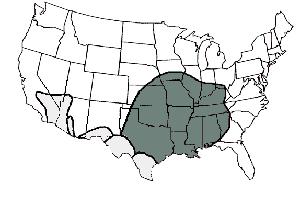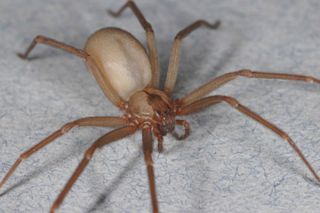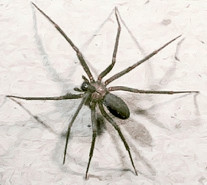Read the full article on: https://gbansandyou.com/brown-recluse-spider/
Many types of spiders live around homes and buildings. Most are harmless, and many are beneficial given they prey upon other nuisance insects, like mosquitos or flies.
This spider sometimes referred to as the ‘violin’ or ‘fiddleback’ spider because of the violin-shaped marking on its dorsum. Brown Recluse Spider is also counted as one of the deadliest and venomous spider. Although their bites are rare, the venom can sometimes cause serious wounds and infestations should be taken seriously.
The Brown Recluse Spider gets its name from its color and its "shy nature. According to experts, "Most spiders go out of their way to avoid humans, which makes sense, but considering us thousands of times larger than them and we don't have a great record of behaving politely toward them."
They are also called by the nicknames of fiddleback spider, brown fiddler, or violin spider. However, today we will about their habits, habitat, threat to humans, preys, and may more. So, here we go...
Read Also:
- How to Backup/Download WordPress theme in 1 minute?
- How many types of play button on YouTube?
- How to prevent copying text from my website?
- Why square weaves are dangerous?
- Why doesn't empty space pull the Earth's atmosphere?
Brown Recluse Spider's habitat?
The brown recluse spider is well-known for its appearance and a poisonous bite. It is the most common and widespread of the brown spiders, but it is found only in the south and the central United States.
Brown recluse spiders live in several regions/states of the USA including Kansas, Oklahoma, Texas, Louisiana, Arkansas, Missouri, Mississippi, Alabama and parts of Georgia, Tennessee, Kentucky, Ohio, Indiana, Illinois, Iowa, and Nebraska.
[caption id="attachment_3653" align="aligncenter" width="332"] Brown Recluse Spider Habitat[/caption]
Brown Recluse Spider Habitat[/caption]
How to identify them?
The brown recluse is part of the Loxosceles genus of spiders. Members of this group have violin-shaped markings on the top of their cephalothorax (fused head and thorax) and may be informally referred to as fiddle back or violin spiders.
The brown recluse's violin marking can vary in intensity depending on the age of the spider, with mature spiders typically having dark violin shapes, according to The Ohio State University. The violin shape points toward the spider's bulbous abdomen. The violin shape is easy to misinterpret, so it is best to look at the eyes when determining if a spider is a brown recluse.

Other types of spiders have eight eyes arranged in rows of four. While Brown Recluse Spiders have six equal-sized eyes arranged in three pairs, called dyads, in a semicircle around the front of the cephalothorax.
Another distinguishing characteristic of the brown recluse spider is its uniformly colored stomach (though the shade of brown varies from spider to spider) covered in fine hairs. Their long, thin legs are also covered in fine hairs and the brown recluse's legs do not have spines, only fine hairs.
They are typically about three-eighths of an inch long and about three-sixteenths of an inch wide (about 1 centimeter long and half a centimeter wide), with males being slightly smaller than females but possessing longer legs.

Where they are found, and How do they live?
Male brown recluse spiders have an average life of 543 days while females have 628 days, but 4-5 years isn't unusual. The female spins an irregular web in undisturbed areas, like the garage, attic, and basement. The web is not used to catch prey, but rather as a retreat.
At outside, brown recluse spiders are typically found around rocks, piles of inner tubes, utility boxes, woodpiles, under bark, etc. These spiders have been found in such places as cedar shake roofs.
Keep reading on: https://gbansandyou.com/brown-recluse-spider/
Comments
Post a Comment